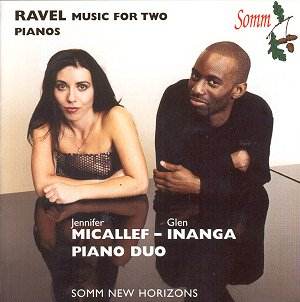Among the many remarkable things about the music of
Ravel is how readily so many of his compositions successfully exist
in two versions, for piano and for orchestra. And of course he also
wrote one of the great orchestral transcriptions when he gave a new
identity to Mussorgsky's Pictures at an Exhibition.
The present collection of music is brilliantly performed
by two talented young pianists, Jennifer Micallef and Glen Inanga. They
are at their best when a brittle and exciting rhythmic texture is required,
in which sense the Laideronette, impératrice des pagodes
movement of Mother Goose is a highlight. This oriental pastiche
is played with tight ensemble and brilliant dexterity.
It is in the slower music that doubts appear, in Mother
Goose and elsewhere. For the languorous rhythms that so often bring
Ravel's special brand of tenderness are sometimes matter-of-fact, the
phrasing under-characterised. The basic shaping of Petit Poucet is
a case in point, for they are less languorous than the music really
needs. Admittedly this is easier to achieve in the orchestral version's
string lines than with the more brittle sound of pianos, but it remains
true.
Mother Goose was originally conceived by Ravel
in this format, whereas much of the remainder of the programme is best
known in orchestral versions. Accordingly there are some rarities on
offer here, such as the two-pianos version of the Introduction and
Allegro, which Ravel made in 1907, one player taking the harp part
while the other has a transcription of the remaining instruments. This
version is hardly known, and I did not find it particularly pleasing,
since the lines sounded unduly abrupt, the textures lacking in subtlety
as compared with the original, which uses harp with flute, clarinet
and string quartet.
The Rapsodie Espagnole is supremely atmospheric
in its orchestral version, and is scored for a large ensemble too. This
is the original version, so the notes claim, but aside from the Habanera
the music again seems prosaic. The arrangement of a later masterpiece,
La Valse, is rather more successful, building to a really exciting
climax which is powerful indeed. The partnership is heard to fine effect
here.
The Somm recording gives accurate and atmospheric sound,
not always easy to achieve with this instrumental combination. And the
booklet is informative and nicely designed, as with other issues from
this label.
Terry Barfoot


